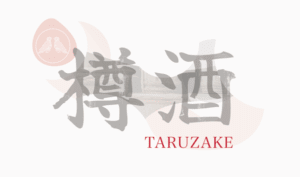Taruzake - sake aged in wooden barrel
Japanese sake is an extremely versatile drink. The different Sake categories help structure the versatility of sake. And in addition to the six (or eight) premium classifications of sake, there are also several special versions by brewing method. In this article, we introduce taruzake.
Taruzake (樽酒) is very special: it preserves the traditional aging in wooden barrels, developing a distinctive cedar aroma.
As a rule, sake is nowadays stored in stainless steel tanks. In Tarusake (the spelling differs German and Japanese) combines the cultivated use of two important natural products: Rice and wood to a special taste. This also gives the drink its name: Tarusake, the sake from a wooden barrel. It provides an interesting insight into Japanese culture.
What is a taru and what is "taruzake"?
"Taru" is a barrel, in the original meaning of the word a wooden barrel. In it the sake matures, it is stored and transported. When it has been stored in a taru long enough to take on some of the wood aroma, this is reflected in the name: Taruzake, meaning "barrel sake.
Japan's alcohol laws do not prescribe a precise definition of "taruzake." However, it is essential that the aromas and flavors develop so clearly that they are recognized as the result of "intentional aging in a wooden barrel" and not as the result of "accidental contact" with the wood aromas.
There is no set storage and aging time in the taru, but the brewer decides how intensively the sake should absorb the wood aroma.
Taru - an indispensable Japanese food container
Wood was important for all areas of life in ancient Japan. Houses, boats and even temples were built from wood. Eating and drinking vessels were made of wood, and food was stored, preserved and transported in wooden barrels. The connection between wood and sake corresponded to the usual storage of alcoholic beverages in the Edo period (1603 - 1868). It was nothing special at that time - today it is the exception.
Japanese love wood as a material
Wood has been highly valued in Japan for centuries, serving not only as a material for useful things, but also considered an element of nature that helps people find relaxation. Also the popular Practice of forest bathing (Shinrin-yoku) shows the deep connection of the Japanese to nature, especially to wood and water.
There is centuries-old evidence of the high artistry of woodworking in Japan. Among others, the Todai-ji temple in Nara, the largest building in the world made only of wood from the year 747, is world-famous. The Sabani wooden boat builders in Okinawa are also well-known. Interiors designed with calm, clear wooden elements are immediately perceived worldwide as typically Japanese. So working with wood has a long and strong tradition in Japan, still none are popular and sought after by carpenters around the world the Japanese saws and other woodworking tools from Japan.
Cedar flavors harmonize with the sake flavors
Cedars are among the most valued trees in Japan. Their wood is flexible and strong, extraordinarily durable and exudes a pleasant fragrance.
Most taru are made from either cedar or pine wood. Cedar taru are so suitable for the aging and storage of sake because their aromas combine harmoniously with those of the sake to produce pronounced freshness. The longer the sake is stored in the taru, the more mature and mild it becomes.
The relationship between sake and Japanese cedar (sugi) is long and full of tradition. With us the wooden Masu drinking vessels known from Japanese cedar. But few know the importance of the relationship between sake and this precious wood.
Yoshino-Sugi, the most valuable cedar for Taru
Yoshino Sugi is a special type of cedar that grows naturally in the forests of Nara Prefecture.
However, there are also centuries-old Yoshino cedar cultures in Japan. These are planted cedars in one of the three largest artificial forests in Japan. Their history dates back as far as 500 years to the Muromachi period. Since that time, these trees have been cultivated using a unique method called the Yoshino method: Seeds come from large cedars that are well suited to the local soil. From these, seedlings are grown and eventually planted out in the mountains.
The unique thing about the Yoshino method is the plantation method, in which 10,000 seedlings per hectare are planted with a spacing of only one meter between trees, twice the usual amount. This method thus provides an environment of high tree density, "forcing" the trees to ever greater heights.
(Source: Tsunekitchi wood processing www.tsunekichi.net)
A recommendable Taruzake presented as an example: Yoshino Sugi no Taruzake
Yoshino Sugi wood is known for its pleasant fragrance, lustrous color, soft, pliable texture, and rot-resistant properties. Sugi has been considered a luxury wood for centuries and has been used in the construction of palaces, shrines, temples, and even shipbuilding. One of the most famous uses of sugi in the past - and still today - was in the manufacture of taru barrels.
In general, of course, a wide variety of wood can be used to make barrels, but Yoshino Sugi is the most popular.
Yoshino Sugi has fragrant reddish wood in the middle section and wonderfully light, almost white wood in the outer section. Both sections of wood can be used to make excellent sake barrels. However, the part with white outside and red inside is especially prized in sake barrel making. The cedar taru is made from the inner section of the tree.
Sake aged in taru made from this precious wood is considered the crowning glory of taruzake. A fine harmony between the cedar wood and the original sake flavors distinguishes the Yoshino Susi no Taruzake and justifies the effort of the wooden barrel storage. Usually nowadays sake is stored in stainless steel tanks, whose advantages are obvious: at the end of the brewing season they can be easily cleaned and sterilized. They are tasteless and do not produce undesirable flavor changes. They are durable, rarely need repair, are safe and fireproof, and ultimately less expensive than wooden kegs. However, a tarusake can only develop that "special something" through its storage in wooden barrels.
Taru as units of volume measurement
Some more information about the capacity of a taru. These units of measurement are divided into three classes called "to".
There are three main classes for the volume of the barrels: the smallest 1-to size has a diameter of about 40 cm and holds 18 liters. The next size, 2-to, measures approximately 50 cm in diameter and holds 36 liters. The largest unit, 4-to, measures about 65 cm in diameter and can hold up to 72 liters.
These 4-to barrels contain enough sake for large parties or ceremonies, such as the Kagamibiraki ceremony. In a 1-to barrel there is enough sake for about 100 - 120 people - whereby of course the drinking pleasure is decisive, so it can happen that even this quantity is only enough for half as many guests.
For interesting background on traditional Japanese units of measure and why sake is often sold in 180ml bottles, see our chapter on sake drinking vessels.

More about Japanese cuisine?
All about sake www.sushiya.de/sake

Sake category Daiginjō
Daiginjō Table of Contents Japanese sake is divided into different categories that provide information about aroma and production criteria. Daiginjō belongs to the high

Rice - central raw material for sake production
To a bottle Sake Junmai category, you need about 1.8 kg of rice - for a Junmai Daiginjō sake, it is already 3 to 3.5 kg of rice as a starting point, since less of the original rice remains here due to the higher degree of polishing.
No wonder that the rice used is of special importance. Here we explain everything about rice as a raw material for sake production.

Taruzake - sake aged in wooden barrel
Taruzake - sake aged in a wooden barrel Table of contents Japanese sake is an extremely versatile drink. The different sake categories help to identify the



